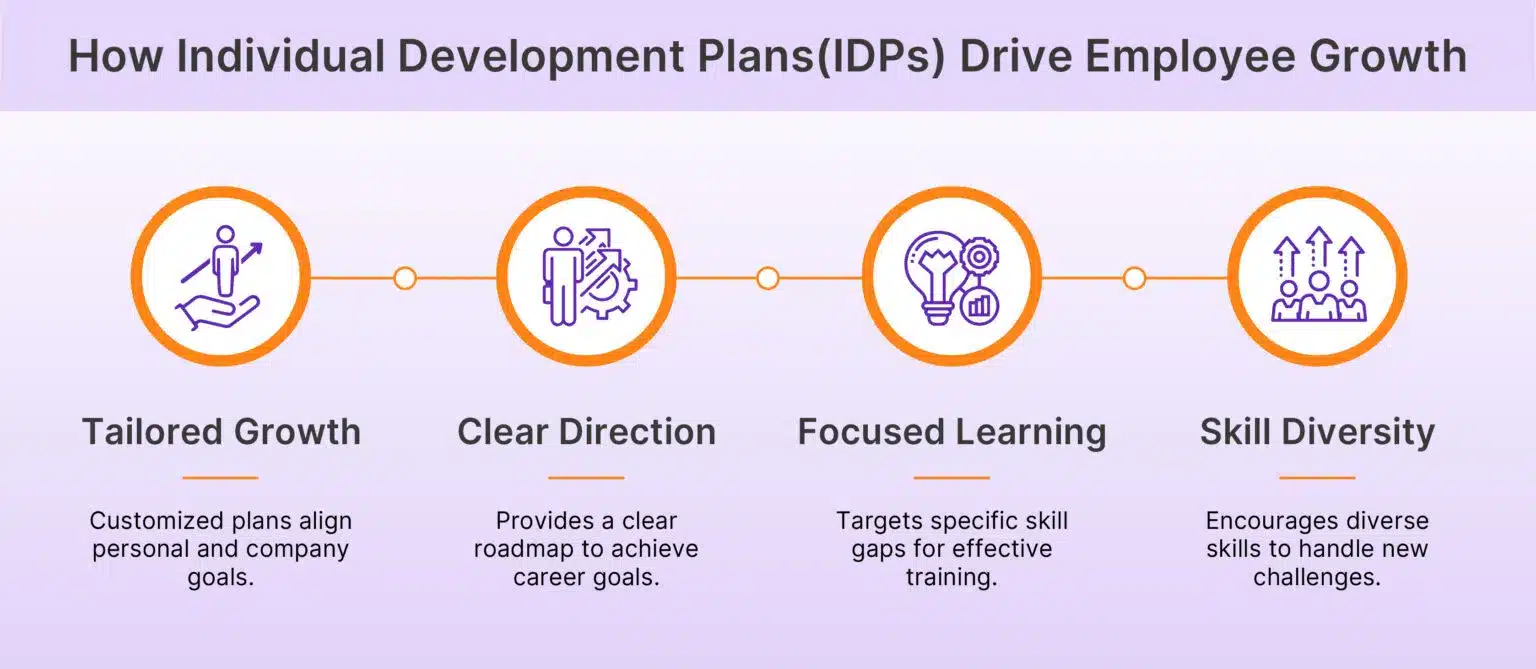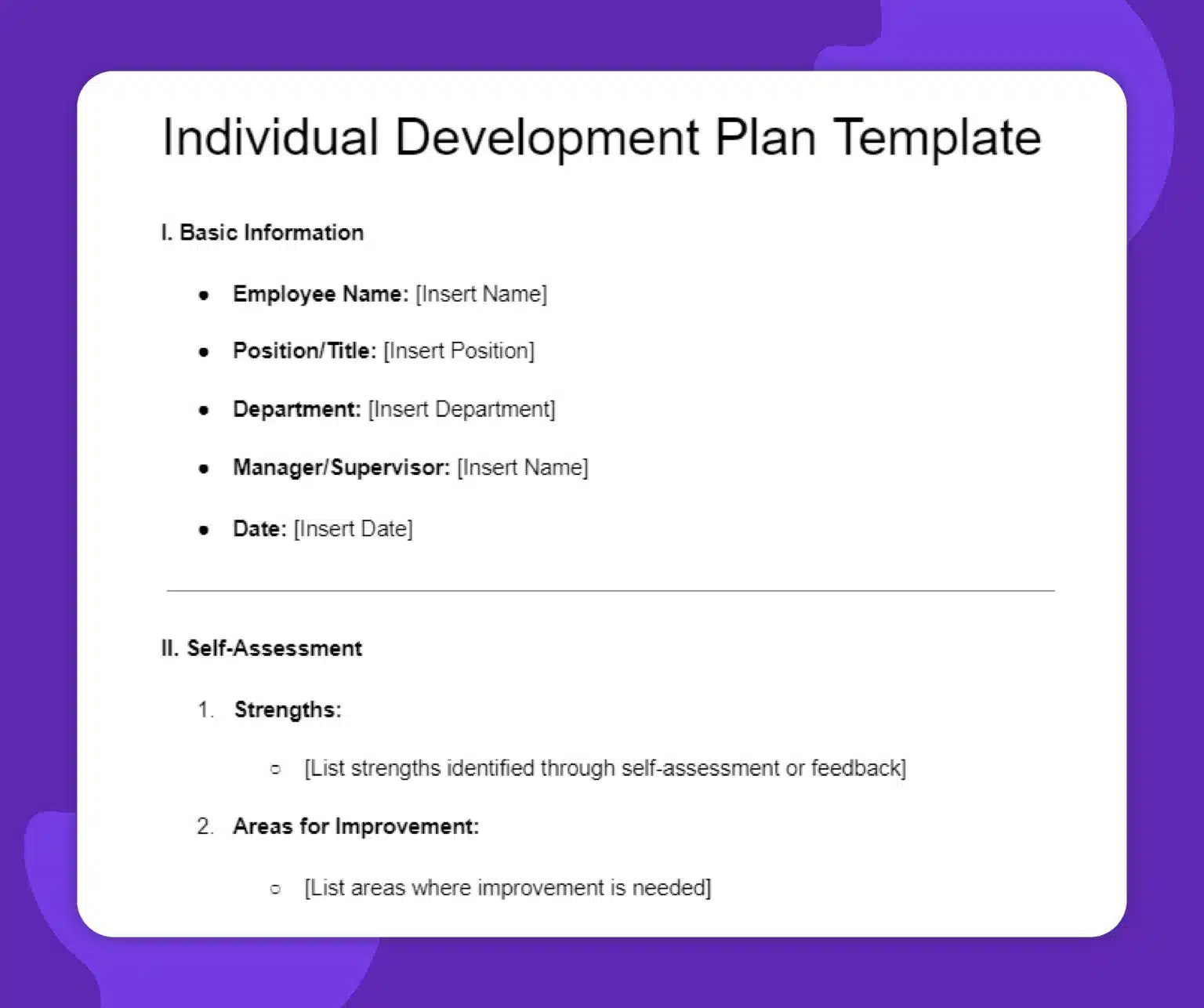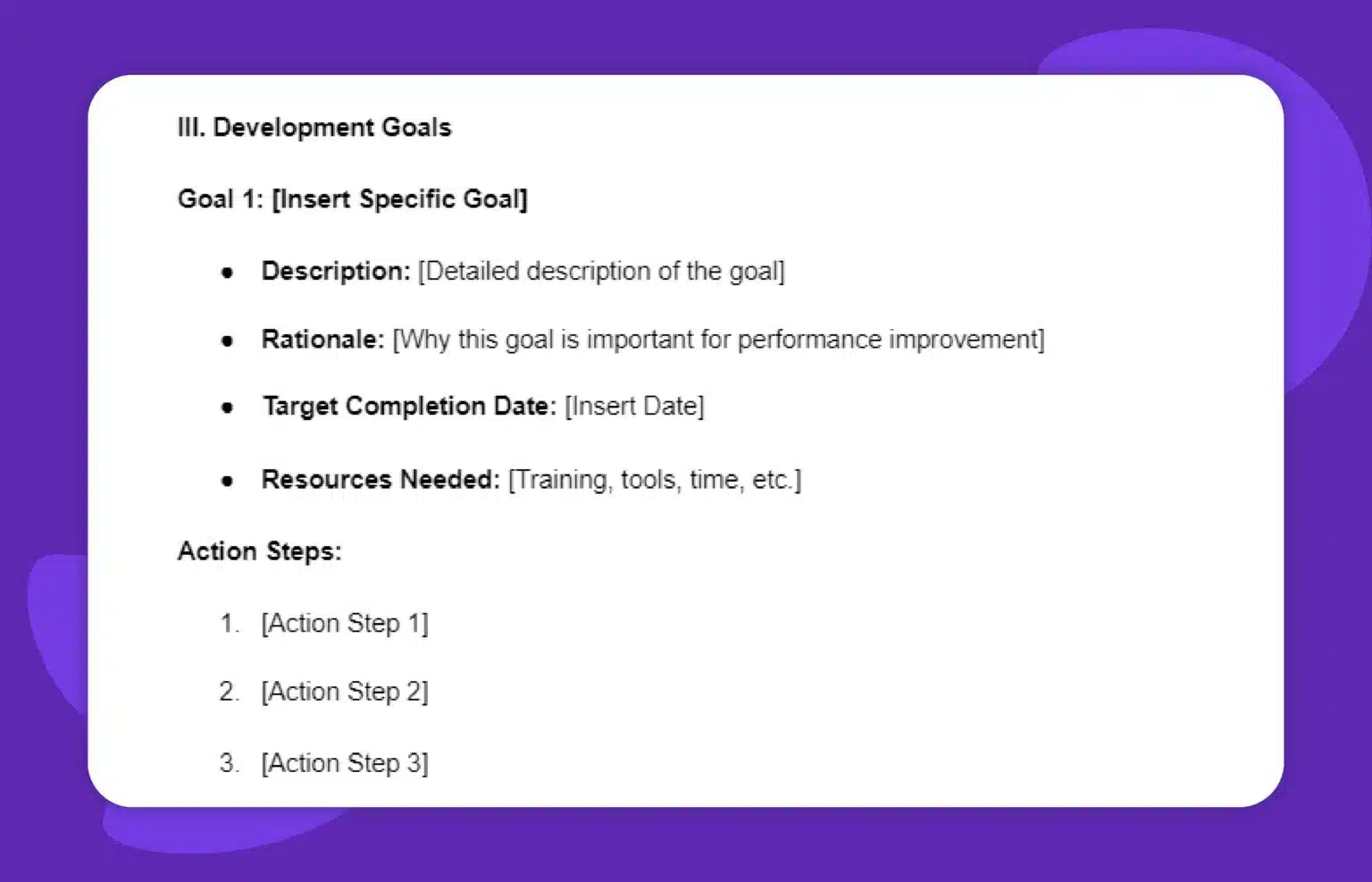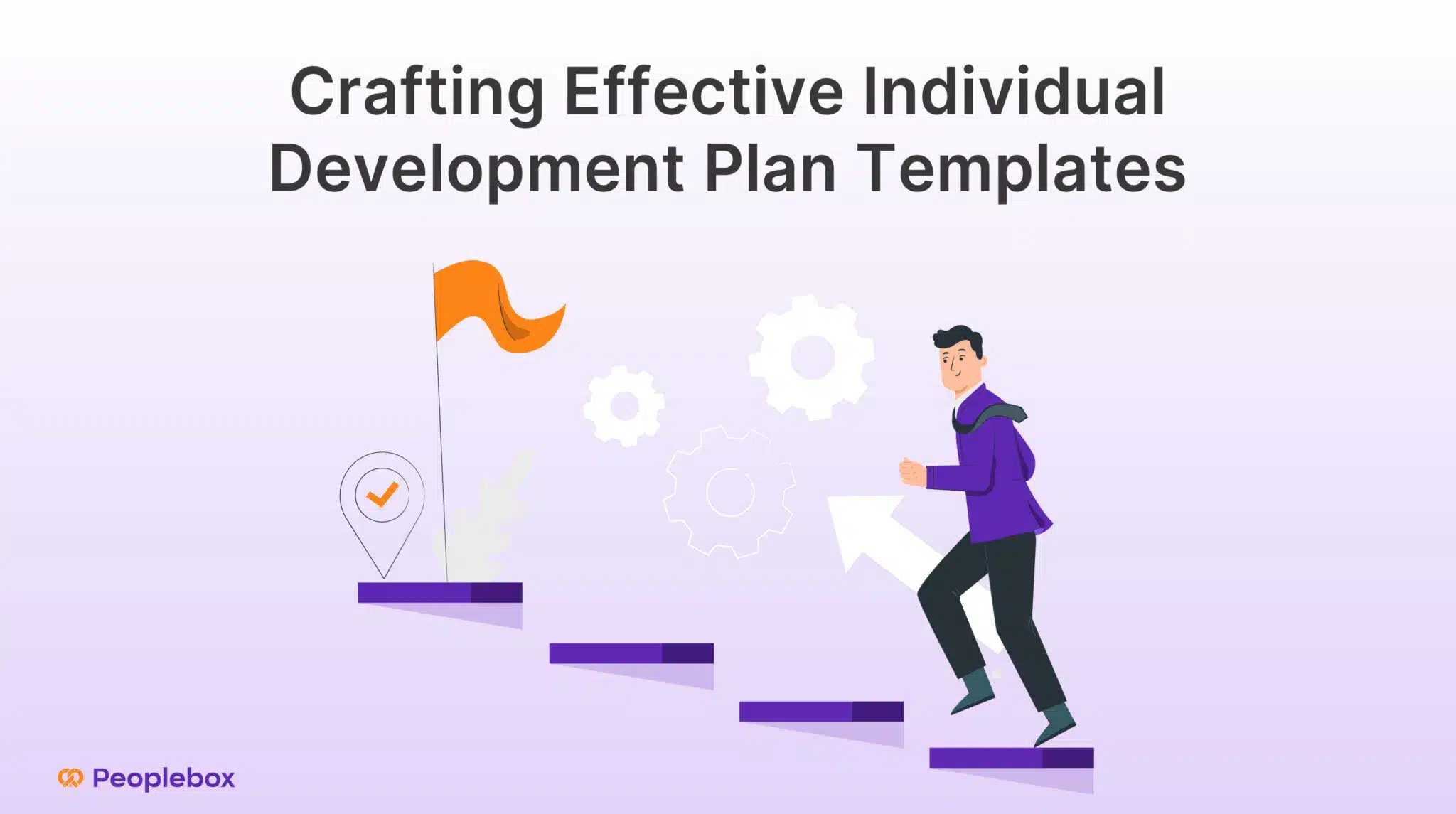As an HR professional, you play a crucial role in supporting the professioanl development of your organization’s most valuable asset – its people. One powerful tool in your toolkit is the Individual Development Plan (IDP) – a personalized roadmap that helps employees identify their strengths, address weaknesses, and achieve their career goals.
An effective IDP not only benefits the individual but also strengthens your entire workforce. By guiding your employees through the process of self-reflection and goal-setting, you can unlock their full potential, boost morale, and cultivate a culture of continuous learning and improvement.
This comprehensive guide provides customizable individual development plan examples and templates and dives deep into everything you need to know about IDPs.
What is an Individual Development Plan?
An Individual Development Plan (IDP) is a talent development framework that is tailored to suit each employee and guide their personal and professional growth. It helps individuals create a clear and actionable plan for driving growth.
An IDP also helps in filling the skill gaps that are accessed during the process. It lets your employees create actionable steps so that they can focus on learning and staying equipped with the required skills for their dream role or goal.
This creates an agile workforce for you which dedicatedly works towards the organization’s success.
It usually contains:
👉 The employee’s desired achievements in the short and long run of their career.
👉 Enhancing existing skills or acquiring new ones, as aimed by the employee.
👉 Skills that you, as a manager, wish the employee to advance further.
👉 Precise action items to realize the goals, such as enrolling in courses, participating in workshops, seeking mentorship, and more.
Suggested read: Individual Development Plans for HR Manager
🤔 Why do you need an individual development plan?
Investing in employee development yields remarkable returns and is essential not only for employees but also for the company. Here’s why:
📈 It facilitates skill development which boosts performance and productivity.
🫂 Its focus on engagement reduces turnover rates and nurtures a loyal, motivated workforce.
🧑🤝🧑 It helps create an internal talent pool for new and bigger responsibilities. A
And this is not all IDP has to offer. When you implement IDP and make it an integral part of your company culture, it aligns personal goals with organizational goals. Apart from this, when you commit to employee development you build a reputation for your company that attracts top talent.
🌱 How Do Individual Development Plans Facilitate Employee Growth?
IDPs are instrumental in fostering employee growth and ensuring that individuals reach their full potential within the organization. Here’s how they achieve this:

➕ Tailored Growth: IDPs are not one-size-fits-all. They are custom-made for each individual. This ensures that each of your employees works on their individual aspirations and strengths and align with the company’s aspirations.
➕ Clear Direction: IDPs provide a clear guideline as to how one can create a well-defined career development plan. With a clear roadmap to success, IDP helps employees stay on track, and take actionable steps toward their goals in the right direction, without losing focus.
➕ Focused Learning: IDPs are highly focused on what needs to be done and achieved. They highlight areas of improvement, enabling managers and HRs to create targeted training programs and development initiatives addressing the identified skill gaps.
➕ Skill Diversity: Through IDPs, employees are encouraged to diversify their skill sets. This well-rounded approach prepares them to handle multifaceted challenges that may come their way with the new responsibilities.
➕ Motivation: IDPs fuel motivation by showing personal progress. As milestones are reached and skills are honed, employees experience a sense of accomplishment that motivates them further.
➕ Continuous Improvement: IDPs are all about perpetual growth. They help foster a culture of learning and ensure that employees remain abreast with the relevant skills and are highly adaptable to challenging situations.
➕ Performance Alignment: With IDPs, skill acquisition aligns seamlessly with job requirements. As a result, employees become skilled and turn into assets for your company. They perform well in their job and contribute meaningfully to organizational success.
➕ Retention: The satisfaction and engagement that stem from embarking on a journey of personal development through IDPs significantly boost employee retention, securing the company’s investment in talent.
Also read: HR Annual Plan: 12-Month Guide to Effective Employee Growth
📋 How To Create Individual Development Plan Template?
Creating an effective IDP template involves several key steps to ensure it is comprehensive, personalized, and actionable. Here’s a step-by-step guide to help you design an IDP template for your employees:

1️⃣ Assess Career Goals
Begin with crystal-clear articulation of the employee’s career aspirations. What are their short-term goals, and where do they envision themselves? This requires a methodical approach, where each career goal is meticulously and clearly defined. This ensures that the roadmap outlines clear action steps to achieve those objectives.
Now, for a company, this is where the concept of collaborative synchronization of goals comes into play. IDPs foster an environment of shared objectives. It blends individual career goals seamlessly with the broader team and organizational objectives.
It is important to recognize that an employee’s professional goals are not isolated plans. They are, in fact, a part of the organizational growth.
2️⃣ Define Measurable Development Goals
This step involves turning aspirations into clear, measurable goals. To achieve this, you can use goal-setting frameworks like OKRs to create clear goals and define key results. This methodology ensures that employees’ goals are not vague but clear targets for them to achieve.

It is also important to ensure that these targets aren’t set in isolation and align with the company’s objectives. By aligning company objectives with individual goals, IDPs serve as a roadmap that guides progress for both.
3️⃣ Identify Development Areas and Training Needs
This is an important part of IDP–identifying areas of development and training requirements. This evaluation requires a thorough assessment of the employee’s current skills, comparing them with the aspired job/role/ goal, and finding the skill gap between the two.
This evaluation highlights areas where skill enhancement and growth are required.
For example, a current ongoing project might require a skill that an employee does not possess. An IDP can help highlight that skill gap under short-term goals.
The employees can ask themselves these questions:
❓ Skill Gap: What skills are critical for my desired future role that I currently lack?
❓ Performance Feedback: Have recent reviews or feedback highlighted any specific skill gaps?
❓ Goal Alignment: What skills do I need to develop to achieve my career goals?
❓ Project Demands: Are there any upcoming projects requiring skills I haven’t mastered?
❓ Training Needs: What specific training or certifications would be most beneficial?
4️⃣ Create Action Plans and Provide Resources
Once the goals are set, the execution takes center stage. This means charting out actionable steps for the set goals. As a manager, it becomes your responsibility to provide the required resources like access to courses, specialized training sessions, workshops, and mentorship opportunities, etc.

5️⃣ Establish a Timeline and Milestones
Defining a timeline and significant milestones is a critical step because without this one can just go on without learning and producing results forever. This highlights the blend of planning ahead and taking steady steps, where development goals are not just thought of but they are given a clear timeline for accomplishment.
This step requires breaking down the goals into meaningful milestones. These milestones act as markers of progress which allow real-time tracking of achievement and enable evaluations.
This ensures that the employee remains on track and the objectives are achieved timely. Here’s a quick example of how you can break the timeline:
Goal: Enhance Project Management Skills
Overall Goal Deadline: December 31, 2024
🎯 Milestone 1: Complete Online Project Management Course
📆 Deadline: March 31, 2024
🗒️ Description: Enroll in and complete a certified project management course such as PMP or PRINCE2.
✅ Evaluation: Submit course completion certificate and reflect on key learnings.
🎯 Milestone 2: Apply Project Management Techniques in a Small Project
📆 Deadline: June 30, 2024
🗒️ Description: Lead a small internal project using the techniques learned in the course.
✅ Evaluation: Present a project report detailing the techniques used and outcomes achieved.
🎯 Milestone 3: Receive Feedback and Improve
📆 Deadline: September 30, 2024
🗒️ Description: Collect feedback from team members and stakeholders on project management skills.
✅ Evaluation: Compile feedback, identify areas for improvement, and create an action plan.
🎯 Milestone 4: Manage a Medium-Sized Project
📆 Deadline: December 31, 2024
🗒️ Description: Take on the role of project manager for a medium-sized project, applying feedback and improving techniques.
✅ Evaluation: Deliver the project successfully and conduct a post-project review with lessons learned.
6️⃣Periodic Reviews and Progress Evaluation
Consistent reviews and evaluations involve establishing a schedule for regular meetings where the employee’s progress is assessed in line with their IDP. These sessions serve as checkpoints to ascertain how well the plan is being executed and whether the intended career growth is being achieved.
The review involves a careful examination of what has been achieved and what hasn’t been. Whether the strategies and actions outlined in the IDP are yielding the desired outcomes, if not then why?
7️⃣ Offering Ongoing Support and Feedback
While this might not be a part of the template, it is an important part of IDP. This involves providing guidance and support to help employees maintain a steady trajectory. This includes offering constructive feedback and acknowledging their achievements.
Acknowledging their positive contributions and offering them feedback acts as a catalyst, motivating individuals to strive for continuous improvement.
This dual strategy of guidance and recognition helps transform IDP into a dynamic instrument of growth for individual development and also a corporate culture rooted in perpetual accomplishment.
8️⃣ Linking IDPs with Performance Management
By aligning IDPs and performance management, you can ensure that employee growth and development are linked to their overall performance assessment.
This integration extends to recognizing and rewarding their achievement in executing their IDPs. As individuals make tangible progress in their personal growth as outlined in their IDPs, their achievements are reflected in the company’s growth as well.
To facilitate this process, features of performance management tools like Peoplebox can be leveraged. It offers comprehensive tracking and goal-setting capabilities which streamlines the connection between IDPs and performance management. It makes it easier to monitor progress, offer timely feedback, facilitate regular check-ins in the form of 1:1 and generate insightful progress reports and analytics.
Performance Review Platform
Get a glimpse of how Peoplebox make performance reviews painless, actionable and fair
Performance Review Questions
9️⃣ Encouraging A Learning Culture Where Employees Feel Motivated To Pursue Development Opportunities
Encouraging a learning culture simply means fostering an atmosphere where learning is not just a requirement, but an intrinsic part of the company. Provide access to resources such as online courses, mentorship programs, and skill-building initiatives to your employees. You can also tailor the resources based on their IDPs.
As a manager, you play a pivotal role in promoting learning initiatives–leading by example, and offering guidance to your team. This not only benefits individual employees but also fosters innovation, adaptability, and a workforce that is always ready to meet new challenges.
Free IDP Template
Creating an IDP can seem daunting, especially when it’s your first time. To make the process easier, we’re sharing a free template that simplifies the development planning journey.
Our Individual Development Plan template provides a structured framework to help you outline the goals, identify the employee’s strengths and weaknesses, and track your progress effectively.
With this template, you can:
👉 Set Clear Objectives: Define your short-term and long-term career aspirations.
👉 Identify Skill Gaps: Recognize areas for improvement and learning opportunities.
👉 Establish a Timeline: Set achievable goals milestones and deadlines to keep you on track.
👉 Monitor Progress: Regularly evaluate your development and adjust your plan as needed.

Questions to Answer in the IDP’s– For Employees
The IDP is a collaborative journey, not a solo mission.
To ensure employees feel invested and contribute meaningfully, involve them in defining each aspect of the plan. These questions will guide them (and you) in crafting an IDP that aligns with their unique interests and aspirations.
Long-Term Career Plan
- What do you want to change in your life, family, community, or work?
- Where do you feel most comfortable? What things do you care about?
- When you retire, what would make you really proud?
- What are your ultimate career goals in the next 5 to 10 years?
- What legacy do you want to leave in your professional life?
- How do you envision your ideal work-life balance in the future?
- What industries or roles excite you the most and why?
- Who do you admire in your field, and what leadership qualities do they possess that you aspire to develop?
Short-Term Career Plan
- What opportunities are available in your current job, team, company, field, or location?
- What challenges do you face that hinder your development?
- What qualities do you want to overcome the challenges and grow in your present or future opportunity?
- What skills or specific knowledge areas would you like to develop in the next year?
- What projects or initiatives in your current role can help you grow?
- How can your manager or team support you in achieving your short-term goals?
- What resources (training, mentorship, etc.) do you need to advance your career?
- What would you consider a successful outcome for your role in the next 6-12 months?
Identifying strengths, weaknesses and learning opportunities
- Which skills do you find easy to use or require less work to do well?
- What do your performance reviews or feedback often highlight about you?
- When do you feel sure about teaching others? Where have you made a difference?
- What helpful suggestions have you gotten from recent reviews or projects?
- Are you aware of the latest certifications and improvements in your field?
- What are your top three strengths that you want to leverage more in your role?
- What areas do you feel less confident in and would like to improve?
- How do you handle feedback, and what steps do you take to apply it?
- What learning methods (e.g., workshops, online courses, mentoring) work best for you?
- Are there any cross-functional teams or departments you’re interested in collaborating with?
- What barriers do you foresee that might affect your learning journey, and how can you overcome them?
🥨 Supercharge Individual Development Plans with Peoplebox
As an organization, embracing a culture of nurturing your employee’s growth is crucial. It is a partnership where you help individuals take active control of their own development while subsequently contributing to the company’s development. IDP is an important contributor to bringing this harmony between individual growth and company objectives.
Peoplebox helps you achieve this seamlessly by combining IDPs with business objectives. It assists in aligning goals and provides constructive feedback through 1:1 meetings, 360-degree feedback, and performance insights.
Take a demo today to learn how Peoplebox helps you with IDPs.
Performance Review Platform
Get a glimpse of how Peoplebox make performance reviews painless, actionable and fair








